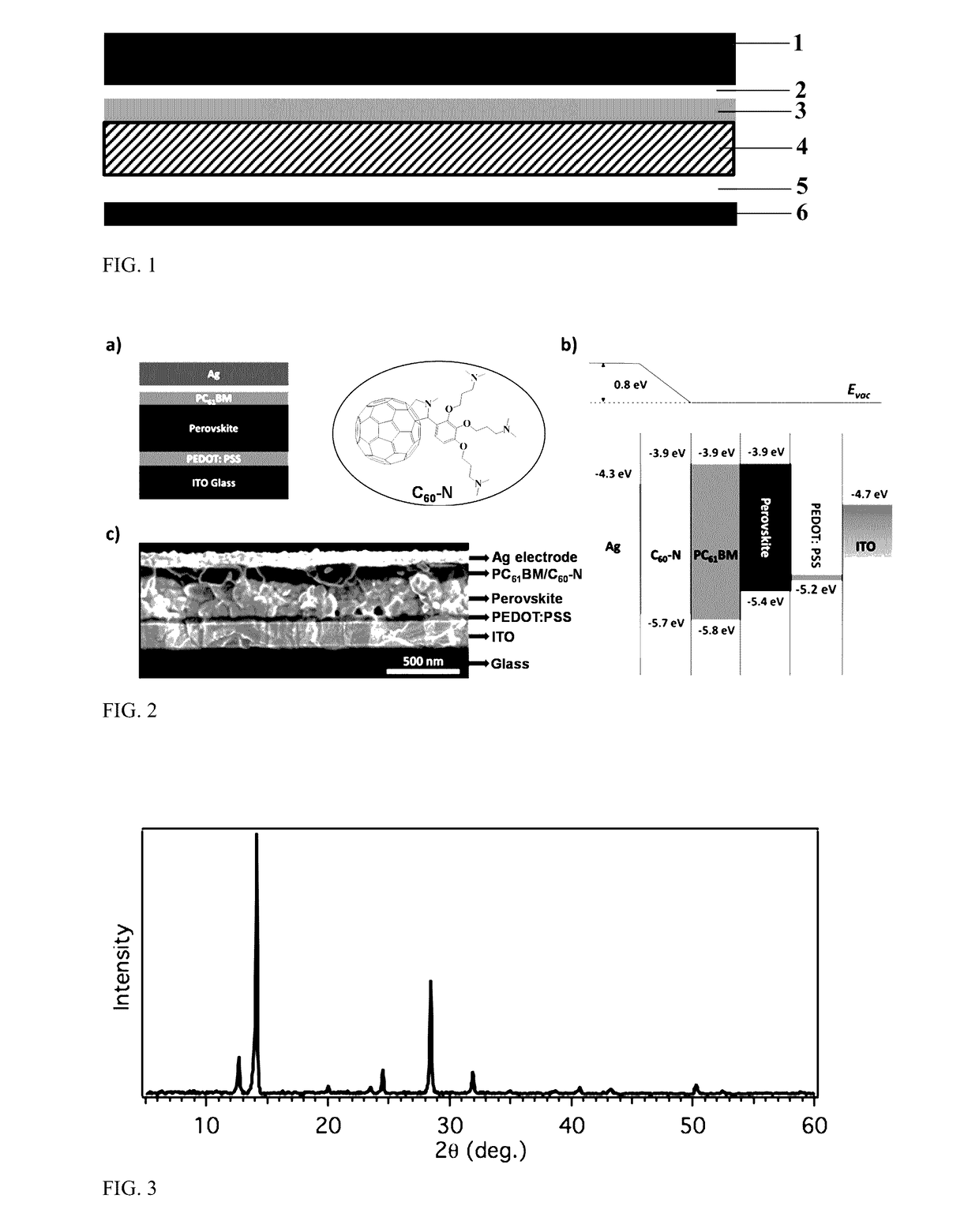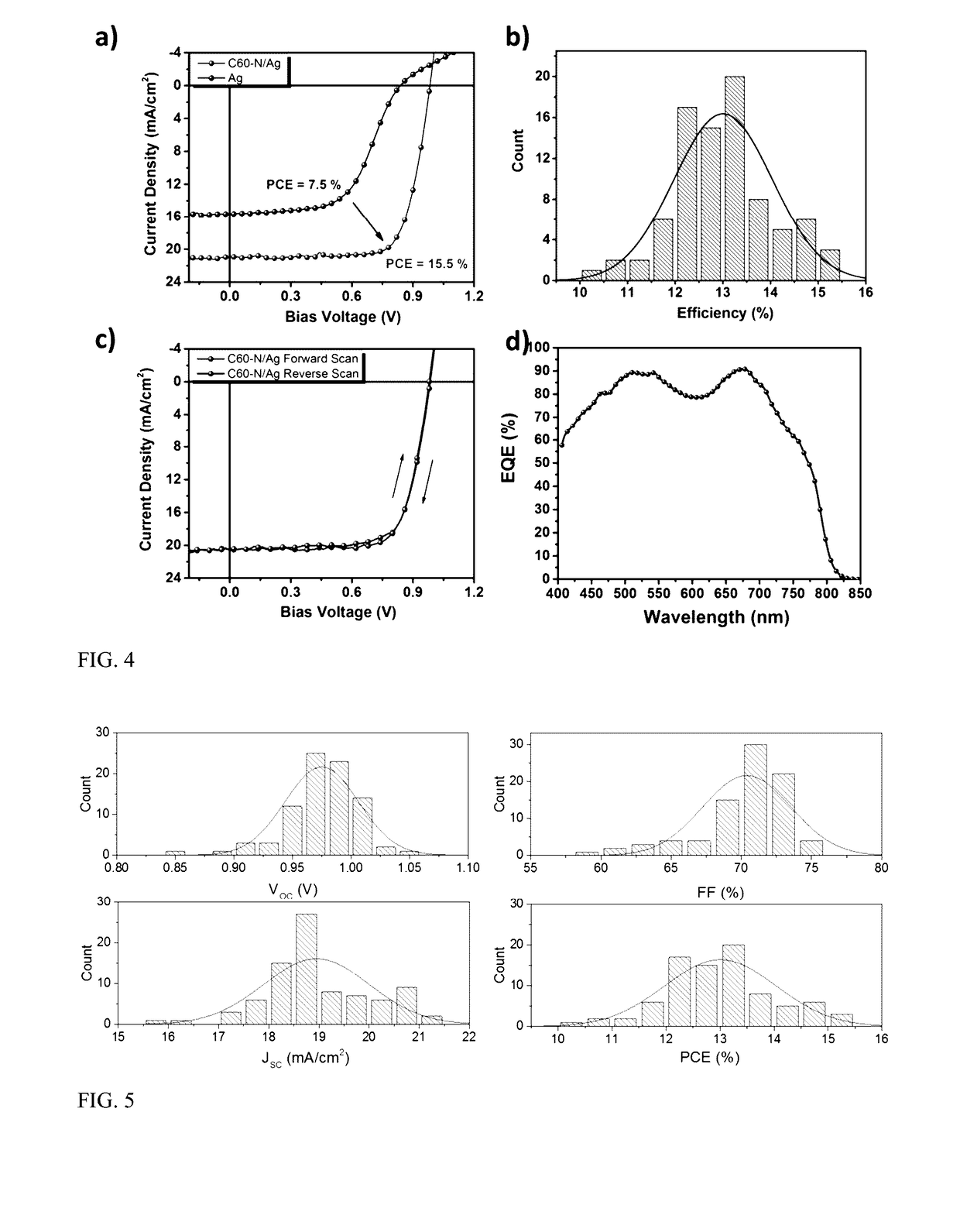Perovskite-containing solar cells comprising fulleropyrrolidine interlayers
a solar cell and fulleropyrrolidine technology, applied in the direction of light-sensitive devices, solid-state devices, electrolytic capacitors, etc., can solve the problems of interface modification's influence on electronic transport and recombination kinetics of perovskite solar cells, which is not fully investigated, and is not compatible with most polymer-based active layers
- Summary
- Abstract
- Description
- Claims
- Application Information
AI Technical Summary
Benefits of technology
Problems solved by technology
Method used
Image
Examples
examples
Inverted Perovskite Solar Cells
[0085]Fullerene / perovskite planar heterojunction solar cells shown in FIG. 2(a) were fabricated by a sequential deposition process starting from indium tin oxide (ITO) (hole extracting electrode). See, e.g., J. Burschka, N. Pellet, S.-J. Moon, R. Humphry-Baker, P. Gao, M. K. Nazeeruddin, M. Gratzel, Nature 2013, 499, 316. The conducing polymer poly(3,4-ethylenedioxythiophene):poly(styrenesulfonate) (PEDOT:PSS), which is widely applied in polymer solar cells as a hole transport layer (HTL), was coated onto ITO to provide a high work function (Φ) electrode (FIG. 2). The lead (II) iodide (PbI2) solution was then spin coated onto PEDOT: PSS modified ITO substrates, followed by thermal annealing, which is critical to promote the crystallization of the as-spun PbI2 film. A mixture of methyl ammonium iodide (MAI) and formamadinium iodide (FAI) (1:1 by weight) was drop coated from isopropanol onto the crystallized PbI2 film, followed by spin coating to remove ...
embodiment 1
[0124]An inverted perovskite solar cell comprising, an anode substrate; a photoactive layer comprising a perovskite; a hole transport layer disposed between the anode substrate and the photoactive layer: an electron transport layer disposed on the photoactive layer; a metal cathode layer; and an interlayer disposed between the electron transport layer and the metal cathode layer, wherein the interlayer comprises a fulleropyrrolidine having structure (I), wherein R1 is independently at each occurrence a divalent C1-12 alkylene group, a C6-30 arylene or heteroarylene group, or an alkylene oxide group; R2 is independently at each occurrence a hydrogen or a C1-12 alkyl group; and R3 is independently at each occurrence a hydrogen or a C1-12 alkyl group.
embodiment 2
[0125]The inverted perovskite solar cell of embodiment 1, wherein the anode substrate comprises indium tin oxide.
PUM
| Property | Measurement | Unit |
|---|---|---|
| Time | aaaaa | aaaaa |
| Thickness | aaaaa | aaaaa |
| Thickness | aaaaa | aaaaa |
Abstract
Description
Claims
Application Information
 Login to View More
Login to View More - R&D
- Intellectual Property
- Life Sciences
- Materials
- Tech Scout
- Unparalleled Data Quality
- Higher Quality Content
- 60% Fewer Hallucinations
Browse by: Latest US Patents, China's latest patents, Technical Efficacy Thesaurus, Application Domain, Technology Topic, Popular Technical Reports.
© 2025 PatSnap. All rights reserved.Legal|Privacy policy|Modern Slavery Act Transparency Statement|Sitemap|About US| Contact US: help@patsnap.com



